Leucaena
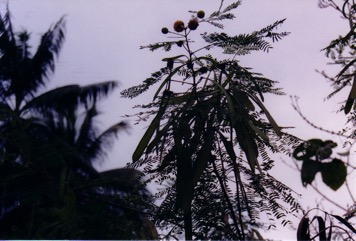
It is a tropical plant. It is introduced and common at low and medium altitudes throughout the tropics. It is widespread from sea level up to about 1700 m altitude in the tropics. It is often used as shade for coffee. It is drought resistant. It grows in the Sahel. It can grow on dry and poor soils. It can tolerate salt. It needs well drained soil and full sun. In Nepal it grows to 1400 m altitude. It can grow in arid places. It suits hardiness zones 10-12. In Yunnan.
Also known as:
Ai-kafe, Aseik-pye, Aweya, Bak kased, Bawzagaing, Bochet, Caribbean tamarind, Cassie, Chigonglei angouba, Epil, Fuapepe, Guaje, Guaje verde, Hawaiian wattle, Horse Tamarind, Huajes, Ipil-ipil, 'ip'ipil, Jongta lem, Jumbie bean, Kamalandingan, Kaniti, Kanthumthet, Kased, Katin, Kawl-zawng-tah, Keo dau, Kok ka thin, Kraset, Krathan, Lamtoro seeds, Lasobaval, Lead tree, Liliaque, Lusia, Lusina, Mlusina, Nagarikesari, Nattuccavundal, Pelending, Petai china, Petai jawa, Peuteui selong, Phak kased, Phak ka thin, Pohon lamtoro, Popinac blanc, Ragarai, Rajokasundiri, Riopriop pen kune, Sneaky tree, Subabool, Takaranniram, Tangantangan, Telentund, Thin thai, Toira kadam, Vaivai, Vilayatibaral, White popinac, Wild tamarind, Wonderboom, Yod phak kased, Zongtasialnek
Synonyms
- Acacia frondosa Willd.
- Acacia glauca (L.) Benth.
- Acacia leucocephala (Lam.) Link
- Leucaena glabra Benth.
- Leucaena glauca Benth.
- Leucaena latisiliqua (L.) Gillis
- Mimosa glauca L.
- Mimosa latisiliqua L.
- Mimosa leucocephala Lam.
Edible Portion
- Leaves, Pods, Fruit, Seeds - coffee, Vegetable
Where does Leucaena grow?
Found in: Africa, American Samoa, Andamans, Angola, Antigua and Barbuda, Argentina, Asia, Australia, Bahamas, Bangladesh, Belize, Benin, Bermuda, Bhutan, Bolivia, Brazil, British Indian Ocean Terr., BIOT, Burkina Faso, Burundi, Cambodia, Cape Verde, Cayman Islands, Central Africa, Central America, Chad, Chile, China, Christmas Island, Colombia, Congo, Costa Rica, Côte d'Ivoire, Cuba, Cyprus, Djibouti, Dominican Republic, East Africa, East Timor, Easter Island, Ecuador, Egypt, El Salvador, Equatorial-Guinea, Eswatini, Ethiopia, Fiji, French Guiana, FSM, Ghana, Grenada, Guam, Guatemala, Guianas, Guinea, Guinée, Guinea-Bissau, Guyana, Haiti, Hawaii, Himalayas, Hispaniola, Honduras, India, Indochina, Indonesia, Ivory Coast, Jamaica, Kenya, Kiribati, Kosrae, Laos, Lebanon, Liberia, Libya, Madagascar, Malawi, Malaysia, Maldives, Mali, Mariana Islands, Marquesas, Marshall Islands, Martinique, Mauritius, Mexico, Micronesia, Mozambique, Myanmar, Namibia, Nauru, Nepal, New Caledonia, Nicaragua, Niger, Nigeria, North Africa, North America, Northeastern India, Pacific, Pakistan, Palau, Panama, Papua New Guinea, PNG, Peru, Philippines, Portugal, Puerto Rico, Reunion, Rotuma, Sahel, Samoa, Sao Tome and Principe, Saudi Arabia, SE Asia, Senegal, Seychelles, Sierra Leone, Slovenia, Somalia, South Africa, Southern Africa, South America, Sri Lanka, St Helena, St. Kitts and Nevis, Sudan, Suriname, Swaziland, Taiwan, Tanzania, Thailand, Timor-Leste, Togo, Tonga, Trinidad, Tuvalu, Uganda, United States, Vanuatu, Venezuela, Vietnam, West Africa, West Indies, West Timor, Yap, Yemen, Zimbabwe
Notes: Also as Mimosaceae.
Status: Leaves and fruit are sold in markets.
Growing Leucaena
Cultivation: It grows easily from seeds. It also regrows from cut stumps and it can be grown from cuttings. Plants are hard to eliminate and can become a weed problem in dry areas.
Edible Uses: The mature seeds are toasted and ground and used as a coffee substitute. They are also added to stews. The young leaves are sometimes used as a vegetable. The leaves can be eaten in small amounts. The tender pods and shoots are cooked as a vegetable. They are used in curries. CAUTION The leaves contain a chemical (mimosine) which causes hair to fall out.
Production: It grows very quickly. It grows to 8 m in 18 months. It can stand only light frosts.
Nutrition Info
per 100g edible portion| Edible Part | Energy (kcal) | Protein (g) | Iron (mg) | Vitamin A (ug) | Vitamin c (mg) | Zinc (mg) | % Water |
|---|---|---|---|---|---|---|---|
| Leaves | 68 | 2.9 | - | - | - | - | 79.5 |
| Leaves & Pods | 59 | 8.4 | 9.2 | - | - | - | 80.7 |
Leucaena Photos

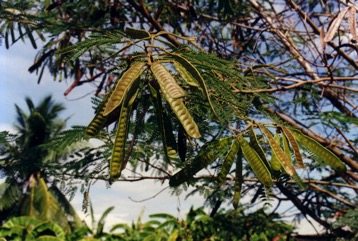
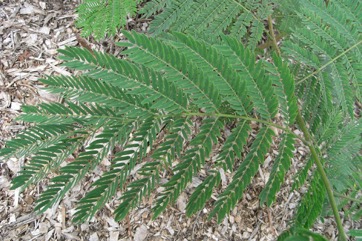
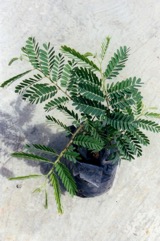
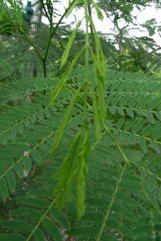
References
Abbiw, D.K., 1990, Useful Plants of Ghana. West African uses of wild and cultivated plants. Intermediate Technology Publications and the Royal Botanic Gardens, Kew. p 42
Ambasta S.P. (Ed.), 2000, The Useful Plants of India. CSIR India. p 325 (As Leucaena glauca)
Anderson, E. F., 1993, Plants and people of the Golden Triangle. Dioscorides Press. p 214
Barwick, M., 2004, Tropical and Subtropical Trees. A Worldwide Encyclopedic Guide. Thames and Hudson p 248
Beasley, J., 2011, Plants of Tropical North Queensland - the compact guide. Footloose publications. p 154
Bodner, C. C. and Gereau, R. E., 1988, A Contribution to Bontoc Ethnobotany. Economic Botany, 43(2): 307-369
Brown, W.H., 1920, Wild Food Plants of the Philippines. Bureau of Forestry Bulletin No. 21 Manila. p 68 (As Leucaena glauca)
Burkill, I.H., 1966, A Dictionary of the Economic Products of the Malay Peninsula. Ministry of Agriculture and Cooperatives, Kuala Lumpur, Malaysia. Vol 2 (I-Z) p 1358 (As Leucaena glauca)
Burkill, H. M., 1985, The useful plants of west tropical Africa, Vol. 3. Kew.
Clarke, W.C. & Thaman, R.R., 1993, Agroforestry in the Pacific Islands: Systems for sustainability. United Nations University Press. New York. p 244
Cooper, W. and Cooper, W., 2004, Fruits of the Australian Tropical Rainforest. Nokomis Editions, Victoria, Australia. p 314
Cribb, A.B. & J.W., 1976, Wild Food in Australia, Fontana. p 108, 175
Cruz, I. M., et al, 2015, Edible fruits and seeds in the State of Mexico. Revista Mexicana de Ciencias Agricolas. Vol. 6. Num. 2 pp 331-346
Cruz-Garcia, G. S., & Price, L. L., 2011, Ethnobotanical investigation of 'wild' food plants used by rice farmers in Kalasin, Northeast Thailand. Journal of Ethnobiology and Ethnomedicine 7:33
Cundall, P., (ed.), 2004, Gardening Australia: flora: the gardener's bible. ABC Books. p 813
Dharani, N., 2002, Field Guide to common Trees & Shrubs of East Africa. Struik. p 246
Etherington, K., & Imwold, D., (Eds), 2001, Botanica's Trees & Shrubs. The illustrated A-Z of over 8500 trees and shrubs. Random House, Australia. p 434
Facciola, S., 1998, Cornucopia 2: a Source Book of Edible Plants. Kampong Publications, p 152 (As Leucaena latisiliqua)
Flora of Australia Volume 12, Mimosaceae (excl. Acacia) Caesalpiniaceae. Melbourne: CSIRO Australia (1998) p 16, 18
Forest Inventory and Planning Institute, 1996, Vietnam Forest Trees. Agriculture Publishing House p 443
Forest Genetic Resources Situation in Mexico, FAO 2012 Annex 15 p 286
Franklin, J., Keppel, G., & Whistler, W., 2008, The vegetation and flora of Lakeba, Nayau and Aiwa Islands, Central Lau Group, Fiji. Micronesica 40(1/2): 169–225, 2008
French, B.R., 1986, Food Plants of Papua New Guinea, A Compendium. Asia Pacific Science Foundation p 359
Gangte, H. E., et al, 2013, Wild Edible Plants used by the Zou Tribe in Manipur, India. International Journal of Scientific and Research Publications, Volume 3, Issue 5
Gonzalez-Insuasti, M. S. and Caballero, J., 2007, Managing Plants Resources: How Intensive Can it be? Human Ecology, 35:303-314
Gouldstone, S., 1983, Growing your own Food-bearing Plants in Australia. Macmillan p 183 (As Leucaena glauca)
Grubben, G. J. H. and Denton, O. A. (eds), 2004, Plant Resources of Tropical Africa 2. Vegetables. PROTA, Wageningen, Netherlands. p 562
Guite, C., 2016, A study of wild edible plants associated with the Paite tribe of Manipur, India, International Journal of Current Research. Vol. 8, Issue, 11, pp. 40927-40932
Hearne, D.A., & Rance, S.J., 1975, Trees for Darwin and Northern Australia. AGPS, Canberra p 82
Henty, E.E., 1980, Harmful Plants in Papua New Guinea. Botany Bulletin No 12. Division Botany, Lae, Papua New Guinea. p 90, 91
Hussey, B.M.J., Keighery, G.J., Cousens, R.D., Dodd, J., Lloyd, S.G., 1997, Western Weeds. A guide to the weeds of Western Australia. Plant Protection Society of Western Australia. p 182
IUCN (2013). Ecological Survey of the Mekong River between Louangphabang and Vientiane Cities, Lao PDR, 2011-2012. Vientiane, Lao PDR: IUCN. 241 pp.
Jackes, B.R., 2001, Plants of the Tropics. Rainforest to Heath. An Identification Guide. James Cook University. p 65
Jacquat, C., 1990, Plants from the Markets of Thailand. D.K. Book House p 40
Japanese International Research Centre for Agricultural Science www.jircas.affrc.go.jp/project/value_addition/Vegetables
Jardin, C., 1970, List of Foods Used In Africa, FAO Nutrition Information Document Series No 2.p 86
J. Bot. (Hooker) 4:416. 1842 - based on "Acacia glauca Willd." which in turn is based on Mimosa glauca L. (1753 = Acacia glauca (L.) Moench)\; non L. glauca sensu Benth. & auct. pl. (= L. leucocephala (Lam.) de Wit) (As Leucaena glauca)
Kar, A., et al, 2013, Wild Edible Plant Resources used by the Mizos of Mizoram, India. Kathmandu University Journal of Science, Engineering and Technology. Vol. 9, No. 1, July, 2013, 106-126
Kenneally, K.E., Edinger, D. C., and Willing T., 1996, Broome and Beyond, Plants and People of the Dampier Peninsula, Kimberley, Western Australia. Department of Conservation and Land Management. p 137
Kiple, K.F. & Ornelas, K.C., (eds), 2000, The Cambridge World History of Food. CUP p 1801
Konsam, S., et al, 2016, Assessment of wild leafy vegetables traditionally consumed by the ethnic communities of Manipur, northeast India. Journal of Ethnobiology and Ethnomedicine, 12:9
Krishen P., 2006, Trees of Delhi, A Field Guide. DK Books. p 291
Kuo, W. H. J., (Ed.) Taiwan's Ethnobotanical Database (1900-2000), http://tk.agron.ntu.edu.tw/ethnobot/DB1.htm (As Leucaena glauca)
Lazarides, M. & Hince, B., 1993, Handbook of Economic Plants of Australia, CSIRO. p 148 (Also as Leucaena glauca)
Lembogi Biologi Nasional, 1980, Sayur-sayuran. Balai Pustaka, Jakarta. p 90
Mahony, D., 1991, Trees of Somalia. A Field Guide for Development Workers. Oxfam Research Paper 3. p 9
Martin, M.A., 1971, Introduction L'Ethnobotanique du Cambodge. Centre National de la Recherche Scientifique. Paris. (As Leucaena glauca)
Maydell, H. von, 1990 Trees and shrubs of the Sahel: their characteristics and uses. Margraf. p 317
McMakin, P.D., 2000, Flowering Plants of Thailand. A Field Guide. White Lotus. p 22
Melzer, R. & Plumb, J., 2011, Plants of Capricornia. Belgamba, Rockhampton. p 536
Menninger, E.A., 1977, Edible Nuts of the World. Horticultural Books. Florida p 96 (As Leucaena glauca)
Monsalud, M.R., Tongacan, A.L., Lopez, F.R., & Lagrimas, M.Q., 1966, Edible Wild Plants in Philippine Forests. Philippine Journal of Science. p 488
Lugod, G.C. and de Padua L.S., 1979, Wild Food Plants in the Philippines. Vol. 1. Univ. of Philippines Los Banos. p 42
Manandhar, N.P., 2002, Plants and People of Nepal. Timber Press. Portland, Oregon. p 291
Martin, F.W. & Ruberte, R.M., 1979, Edible Leaves of the Tropics. Antillian College Press, Mayaguez, Puerto Rico. p 85, 199
Milson. J., 2000, Trees and Shrubs of north-west Queensland. DPI p 166
Ochse, J.J. et al, 1931, Vegetables of the Dutch East Indies. Asher reprint. p 393 (As Leucaena glauca)
Pawera, L., et al, 2020, Wild Food Plants and Trends in Their Use: From Knowledge and Perceptions to Drivers of Change in West Sumatra, Indonesia, Foods. 2020, 9, 1240
Peekel, P.G., 1984, (Translation E.E.Henty), Flora of the Bismarck Archipelago for Naturalists, Division of Botany, Lae, PNG. p 210, 208
Pena, F. B., et al, 1998, Los quelites de la Sierra Norte de Puebla, Mexico: Inventory Y Formas de Preparacion. Bol. Soc. Bot. Mexico 62:49-62
Pham-Hoang Ho, 1999, An Illustrated Flora of Vietnam. Nha Xuat Ban Tre. p 820
Phon, P., 2000, Plants used in Cambodia. © Pauline Dy Phon, Phnom Penh, Cambodia. p 400
Plants of Haiti Smithsonian Institute http://botany.si.edu/antilles/West Indies
Prixar, S., et al, 2006, Species composition, distribution and management of trees in paddy fields in central Laos. p 22
Priyadi, H., et al, Five hundred plant species in Gunung Halimun Salak National Park West Java. A checklist including Sundanese names, distribution and use. CIFOR, FFPRI, SLU p 141
Royal Botanic Gardens, Kew (1999). Survey of Economic Plants for Arid and Semi-Arid Lands (SEPASAL) database. Published on the Internet; http://www.rbgkew.org.uk/ceb/sepasal/internet [Accessed 28th April 2011]
Sakunpak, A. & Panichayupakaranant, P., 2012, Antibacterial activity of Thai edible plants against gastrointestinal pathogenic bacteria and isolation of a new broad spectrum antibacterial polyisoprenylated benzophenone, chamuangone. Food Chemistry 130 (2012) 826–831
Segura, S., et al, 2018, The edible fruit species in Mexico. Genet Resour Crop Evol (2018) 65:1767–1793
Selvam, V., 2007, Trees and shrubs of the Maldives. RAP Publication No. 2007/12 p 108
Singh, S.R. and Singh, N.I., 1985, A Preliminary Ethnobotanical studies on wild edible plants in the markets of Manipur - 1. J. Econ. Tax. Bot. Vol. 6 No. 3 pp 699-703 (As Leucaena glauca)
Slik, F., www.asianplant.net
Staples, G.W. and Herbst, D.R., 2005, A tropical Garden Flora. Bishop Museum Press, Honolulu, Hawaii. p 333
Sujanapal, P., & Sankaran, K. V., 2016, Common Plants of Maldives. FAO & Kerala FRI, p 167
Sukarya, D. G., (Ed.) 2013, 3,500 Plant Species of the Botanic Gardens of Indonesia. LIPI p 355
Taxon 10:54. 1961
Terra, G.J.A., 1973, Tropical Vegetables. Communication 54e Royal Tropical Institute, Amsterdam, p 56 (As Leucaena glauca)
Thaman, R. R, 2016, The flora of Tuvalu. Atoll Research Bulletin No. 611. Smithsonian Institute p 90
Topp, J. M. W., 1988, An Annotated Check List of the Flora of Diego Garcia, British Ocean Territory. Atoll Research Bulletin No. 313
Verdcourt, B., 1979, Manual of New Guinea Legumes. Botany Bulletin No 11, Division of Botany, Lae, Papua New Guinea. p 154
Westerway, J., et al, 2018, Preliminary checklist of the naturalised and pest plants of Timor-Leste. Blumea 63:157-163
Wheeler, J.R.(ed.), 1992, Flora of the Kimberley Region. CALM, Western Australian Herbarium, p 339
Whistler, W.A., 2004, Rainforest Trees of Samoa. Isle Botanica Honolulu, Hawaii. p 74
World Checklist of Useful Plant Species 2020. Royal Botanic Gardens, Kew
www.worldagroforestrycentre.org/treedb/
Xu, You-Kai, et al, 2004, Wild Vegetable Resources and Market Survey in Xishuangbanna, Southwest China. Economic Botany. 58(4): 647-667.
Zizka, G., 1991, Flowering Plants of Easter Island. Palmarum Hortus Francofurtensis